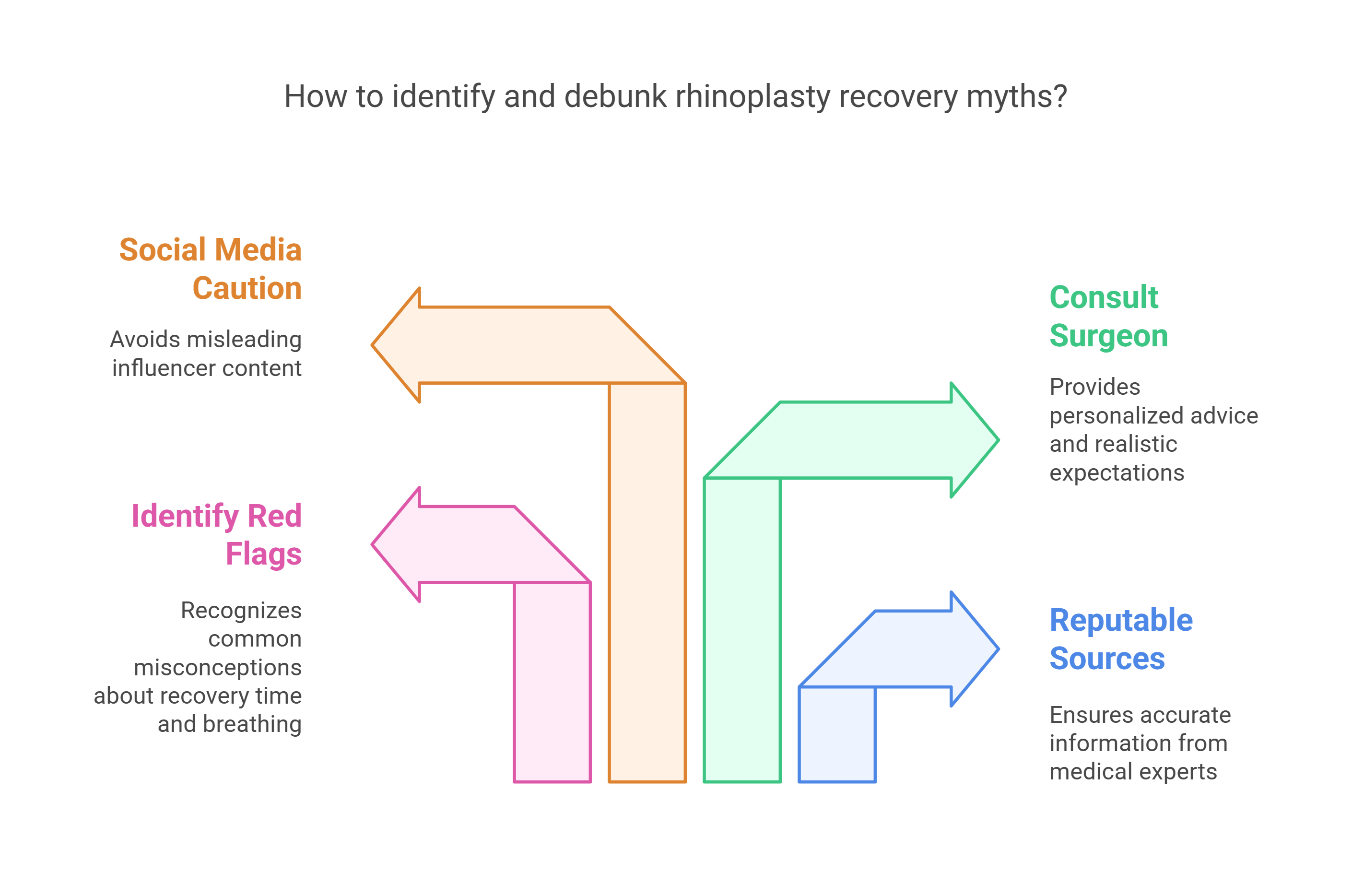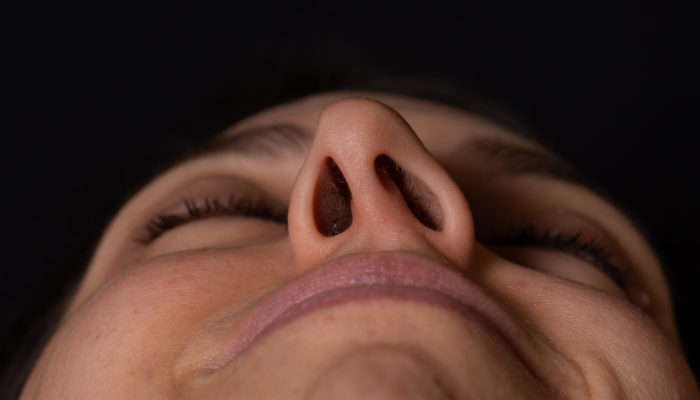Let’s say you’ve finally done it—said goodbye to the nose that never felt quite right and hello to a new, refined version. But now comes the part that doesn’t always get the spotlight: recovery. The truth is, rhinoplasty healing isn’t just about waiting for swelling to go down; it’s a journey filled with unexpected stages, surprising sensations, and a bit of patience.
This article breaks down the recovery time for rhinoplasty, covering everything from the immediate aftermath to long-term care, and offers some handy tips to ensure your recovery goes as smoothly as possible.
Key Takeaways
- Recovery from rhinoplasty generally takes about 6 to 8 weeks, but full healing can take up to a year.
- Following your surgeon’s post-operative instructions is crucial for a smooth recovery.
- Swelling is most pronounced in the first week and gradually decreases over the next few months.
- It’s important to manage pain and rest properly during the initial recovery phase.
- Support from friends, family, and professionals can significantly aid your recovery process.
Understanding Rhinoplasty Recovery Time
So, you’re considering rhinoplasty, or maybe you’ve already booked your surgery – exciting times! One of the biggest things on everyone’s mind is, naturally, the recovery. It’s not a sprint, it’s more of a marathon, but knowing what to expect can make the whole process much less daunting.
Let’s break down what influences the rhinoplasty recovery timeline and how to set yourself up for a smoother experience.
Initial Recovery Expectations

Let’s get real about what the first few weeks are like. You’ll likely have some swelling and bruising – it’s just part of the deal. Most people find the first week or two the most challenging, but it gets better quickly. You’ll probably have a splint and maybe some packing in your nose, which can feel a bit stuffy.
Pain is usually manageable with medication. The key thing is to be prepared to take it easy and focus on resting.
Factors Influencing Recovery Duration
Not everyone heals at the same rate, and that’s perfectly normal. Several things can affect how long your recovery takes:
- The extent of the surgery: A minor tweak will obviously mean a quicker recovery than a major reconstruction.
- Your overall health: If you’re generally healthy, you’re likely to heal faster.
- Your age: Younger people tend to heal more quickly than older people.
- Following post-op instructions: This is a big one! Sticking to your surgeon’s advice is crucial.
It’s important to remember that everyone’s body is different. Don’t compare your recovery to someone else’s. Focus on your own progress and listen to your body.
Importance of Following Post-Op Instructions
Seriously, this is the most important thing you can do. Your surgeon will give you a detailed list of instructions, and they’re not just suggestions. These instructions are designed to minimise complications and help you heal as quickly and effectively as possible. This includes things like:
- Taking your medication as prescribed.
- Avoiding strenuous activity.
- Sleeping with your head elevated.
- Attending all follow-up appointments.
Think of your surgeon as your guide, and their instructions as the map to a successful recovery. Stick to the plan, and you’ll be well on your way to enjoying your new nose.
Immediate Post-Operative Care
The next few days are all about taking it easy and following your surgeon’s instructions. It might feel a bit weird at first, but trust me, it’s all part of the process. Let’s break down what you can expect and how to handle it.
Managing Pain and Discomfort
Let’s be real, there’s gonna be some discomfort. It’s totally normal to feel some pain after surgery, but the good news is it’s manageable. Your surgeon will likely prescribe pain medication, so make sure you take it as directed.
Don’t wait until the pain is unbearable before popping a pill; stay ahead of it. Besides medication, cold compresses can be your best friend. Apply them gently to your cheeks and around your nose to help numb the area and reduce swelling. Just remember to wrap the ice pack in a cloth to protect your skin.
Signs of Complications to Watch For
While most rhinoplasty recoveries go smoothly, it’s important to keep an eye out for any potential complications. Here’s what to watch for:
- Excessive Bleeding: A little bit of oozing is normal, but if you’re soaking through bandages, that’s a red flag.
- Signs of Infection: Look for increased redness, warmth, pus, or a fever. These could indicate an infection that needs immediate attention.
- Severe Pain: If your pain is not controlled by medication or is getting worse, contact your surgeon.
- Breathing Difficulties: While some congestion is expected, any significant difficulty breathing should be reported.
If you notice any of these signs, don’t hesitate to contact your surgeon’s office. It’s always better to be safe than sorry.
Importance of Rest and Elevation
Rest is absolutely key during the initial recovery phase. Your body needs time to heal, so don’t push yourself. Avoid strenuous activities, and try to get plenty of sleep. When you’re resting, keep your head elevated.
This helps to reduce swelling and promote proper blood flow. Use a couple of pillows to prop yourself up, even when you’re sleeping. Think of it as a good excuse to binge-watch your favourite shows from a comfy position. Seriously, though, elevation is a simple but effective way to speed up your recovery.
Swelling Stages After Rhinoplasty
Swelling is a pretty common side effect, and understanding the timeline can really help manage your expectations and keep you feeling positive throughout the recovery. Everyone heals at their own pace, but here’s a general idea of what to anticipate.
First Week: Initial Swelling
The first week is usually when the swelling is at its peak. Don’t be alarmed if you look a bit puffy – it’s totally normal! You’ll likely have some bruising around your eyes too, which can be a bit confronting. The swelling might even feel worse around day three or four before it starts to get better.
Just keep up with your post-op instructions, like using cold compresses and keeping your head elevated. This is also when you’ll probably have a splint or cast on your nose, which adds to the overall ‘swollen’ look. Hang in there; it does get better!
Weeks Two to Four: Reducing Inflammation
Things start to improve during weeks two to four. The majority of the initial swelling should begin to subside, and the bruising will start to fade. You’ll probably notice that your nose looks more ‘normal’ again, although there will still be some residual swelling.
It’s a gradual process, so don’t expect a dramatic change overnight. Keep following your surgeon’s advice, and avoid anything that could increase swelling, like strenuous exercise.
Months Three to Six: Continued Healing
After the first month, the swelling reduces more slowly. By months three to six, you’ll see continued refinement in your nasal shape. The tip of your nose is often the last area to fully settle, so don’t be surprised if it still feels a bit firm or looks slightly swollen.
Most of the noticeable swelling should be gone by this point, but subtle changes can still occur. Be patient, and remember that the final result can take up to a year or even longer to fully materialise.
It’s important to remember that everyone’s recovery is different. Factors like your age, skin type, and the extent of the surgery can all influence how long the swelling lasts. If you have any concerns, don’t hesitate to contact your surgeon. They’re there to support you throughout the entire process.
Long-Term Recovery Considerations
It’s easy to focus on the initial weeks after rhinoplasty, but it’s important to remember that the healing process continues for many months. Understanding what to expect in the long term can help you manage your expectations and ensure the best possible outcome. Let’s look at what you should keep in mind.
Final Results Timeline
Okay, so you’ve made it through the initial swelling and bruising. What’s next? Well, the final results of your rhinoplasty can take quite a while to fully materialise. It’s not unusual to wait up to a year, or even longer, to see the complete picture.
The tip of the nose, in particular, can be stubborn and retain swelling for an extended period. Be patient! It’s a gradual process, and you’ll likely notice subtle improvements over time. Don’t stress if things don’t look perfect right away.
Ongoing Care and Maintenance
Even after the initial recovery period, there are things you can do to maintain the results of your rhinoplasty. This might include:
- Protecting your nose from sun exposure with sunscreen.
- Avoiding activities that could cause trauma to the nose, like contact sports, without proper protection.
- Maintaining a healthy lifestyle to promote overall healing and well-being.
It’s also worth noting that the natural ageing process will continue to affect your nose, just as it would have without surgery. While rhinoplasty can provide long-lasting improvements, it doesn’t stop the clock.
When to Consult Your Surgeon
While most of the long-term recovery is uneventful, it’s still important to stay in touch with your surgeon. Schedule follow-up appointments as recommended, and don’t hesitate to reach out if you have any concerns.
Things like persistent pain, unusual swelling, or changes in the shape of your nose should be reported promptly. Your surgeon is there to support you throughout the entire process, so make use of their expertise.
Tips for a Smooth Recovery Process
Dietary Recommendations
What you eat really does matter, especially when your body is trying to heal. Focus on foods that will help reduce inflammation and give your body the nutrients it needs.
- Prioritise protein: It’s essential for tissue repair.
- Load up on vitamins: Especially A and C, found in fruits and vegetables.
- Stay hydrated: Water helps with everything, including reducing swelling.
Physical Activity Guidelines
It’s tempting to jump back into your normal routine, but patience is key here. Overdoing it can set you back, so listen to your body and take it easy. I tried to do too much too soon and ended up with more swelling than I needed. Not fun.
- Avoid strenuous exercise: For at least a month, maybe longer.
- Gentle walks are good: But don’t push yourself.
- Skip bending over: It can increase pressure in your face.
Mental Wellbeing During Recovery
Rhinoplasty recovery is mental too. It’s easy to get down when you’re stuck at home and not seeing immediate results. Remember that healing takes time, and it’s okay to feel a bit blah. I found that keeping busy with light activities and staying connected with friends really helped.
- Set realistic expectations: The final result takes time.
- Find relaxing activities: Reading, gentle music, or meditation can help.
- Stay connected: Talk to friends and family, or join a support group.
It’s important to remember that everyone’s recovery is different. Don’t compare yourself to others, and focus on what you can do to support your own healing process. A positive attitude can make a big difference.
Common Myths About Rhinoplasty Recovery

It’s easy to get caught up in misinformation when researching rhinoplasty. Let’s debunk some common myths to help you have realistic expectations and a smoother recovery.
Understanding Realistic Expectations
It’s important to have realistic expectations about what rhinoplasty can achieve. It can enhance your appearance and improve breathing, but it won’t transform you into a completely different person.
Discuss your goals with your surgeon to ensure they align with what’s possible. Remember, everyone heals at their own pace, and comparing your recovery to others can lead to unnecessary anxiety.
The Role of Professional Guidance
Your surgeon and their team are your best resource for accurate information and support during recovery. Don’t rely solely on online forums or anecdotal advice. They can provide personalised guidance based on your specific procedure and medical history. Regular follow-up appointments are essential to monitor your progress and address any concerns promptly.
Remember, a successful rhinoplasty recovery relies on a combination of realistic expectations, adherence to post-operative instructions, and open communication with your surgical team. Don’t hesitate to reach out if you have any questions or concerns along the way.
Support Systems During Recovery
Having a solid support system can make a massive difference in how smoothly you get through it. It’s easy to underestimate how much you’ll need people around you, but trust me, you will.
Importance of Family and Friends
Family and friends can provide practical help, like driving you to appointments or helping with household chores. But more than that, they offer emotional support. Having someone to talk to about your worries and anxieties can be incredibly reassuring.
It’s nice to have someone around to just watch a movie with, or make you a cup of tea. Don’t be afraid to ask for help; most people are happy to lend a hand.
Professional Support Options
Sometimes, you need more than just the support of loved ones. That’s where professional support comes in. Therapists or counsellors can provide a safe space to process your feelings about the surgery and its impact on your self-image. Support groups, either in person or online, can connect you with others who have gone through similar experiences. Your surgeon’s office might also offer resources or referrals to specialists who can help.
It’s easy to feel isolated during recovery, but remember you’re not alone. Many people have gone through this, and there are professionals ready to help you navigate the emotional challenges.
Community Resources for Patients
Beyond family, friends, and therapists, there are community resources that can offer support. These might include:
- Online forums and communities dedicated to rhinoplasty patients.
- Local support groups or workshops focused on cosmetic surgery recovery.
- Patient advocacy groups that can provide information and guidance.
- Hospital or clinic-based support services.
These resources can provide a sense of community and connection, helping you feel less alone during your recovery. They can also offer practical tips and advice from people who have been there, done that.
Conclusion
Recovering from rhinoplasty is a journey that requires patience and care. While the initial healing phase can be challenging, consulting to a qualified surgeon with decade of experience in surgical expertise can make it easier. Remember, everyone’s recovery timeline is different, and it’s important to follow your surgeon’s advice closely.
Take the time to rest, manage your expectations, and allow your body to heal properly. With the right approach, you’ll be on your way to enjoying the results of your procedure. Stay positive and trust the process—your new look is just around the corner!
Frequently Asked Questions
How long does it take to recover from rhinoplasty?
Recovery from rhinoplasty usually takes about 6 to 8 weeks for most people, but full healing can take up to a year.
What should I expect in the first week after surgery?
In the first week, you may experience swelling and bruising. It’s important to rest and follow your doctor’s advice.
Can I go back to work after rhinoplasty?
Most people can return to work after about 1 to 2 weeks, but this depends on how you feel and the type of work you do.
How can I reduce swelling after my nose job?
To help reduce swelling, keep your head elevated, apply cold compresses, and avoid strenuous activities.
Are there any signs of complications I should watch for?
Yes, look out for severe pain, excessive bleeding, or signs of infection like fever. Contact your surgeon if you notice these.
When can I see the final results of my rhinoplasty?
You might see significant changes within a few months, but the final results can take up to a year to fully settle.





